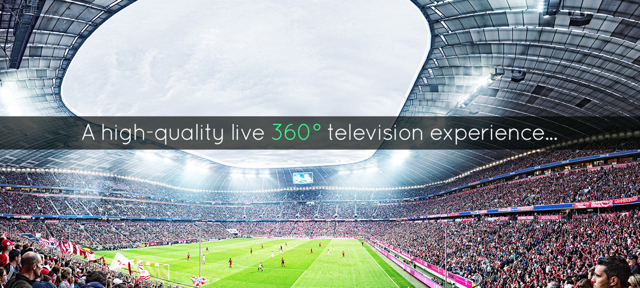LiveSphere: 360-Degree Immersive Broadcast Video Platform
June 17, 2014
Journalist and ETCentric contributor Adrian Pennington forwarded us news that the LiveSphere 360-degree broadcast video application, which is presently under development in France and is at least a year from a commercial product, was tested during the recent Roland-Garros tennis tournament. LiveSphere is being developed by compression specialist ATEME in partnership with Kolor, maker of photo and video stitching software, and mobile interaction expert Finwe.
“The aim is to create a turnkey broadcast system that captures, stitches, streams and displays video to provide an immersive consumer experience for second screens, including virtual reality headsets,” writes Pennington for TVBEurope.
“The part that attracts most attention is how the picture stitching is done, but the part that enables us to build a business out of this technology is the efficient means of compressing the entire video sphere and the ability to match it to the best decoding capability of the smartphone or tablet to render the best results,” said Benoit Fouchard, chief strategy officer for ATEME.
“There are no solutions in existence that match the needs of the broadcast market,” he explained. “We don’t intend to offer this as a service model but as an end-to-end solution that puts these tools in the hands of the same production team producing the HD or Ultra HD main feed.”
Interestingly, he also downplayed the virtual reality angle: “We don’t want to give the impression that 360-degree video is just for VR where you have to wear headsets, because this is the issue that proved problematic for the public perception of 3D.”
During the Roland-Garros tests, a rig comprised of seven HD GoPro cameras was used from different positions. The best images were captured closer to the action. A multi-camera approach may not be a permanent solution, but Fouchard noted that, “single camera panoramic video doesn’t work for broadcast.”
While the system stitches multiple streams together with an output of less than HD, the goal is to achieve similar results in 4K and 8K.
“The secret sauce, however, is from ATEME and concerns the ability for viewers to choose and dynamically modify their field of view by either moving the display or touching the screen,” writes Pennington.
The team is moving cautiously to develop “a long term professional broadcast application” rather than “a gadget or gimmick,” said Fouchard. In addition to sports, the technology is being considered for targeted hotspots in advertising, multiple views during music concerts, navigation during reality TV shows, and more.
Video demos are available on the LiveSphere site.


No Comments Yet
You can be the first to comment!
Sorry, comments for this entry are closed at this time.